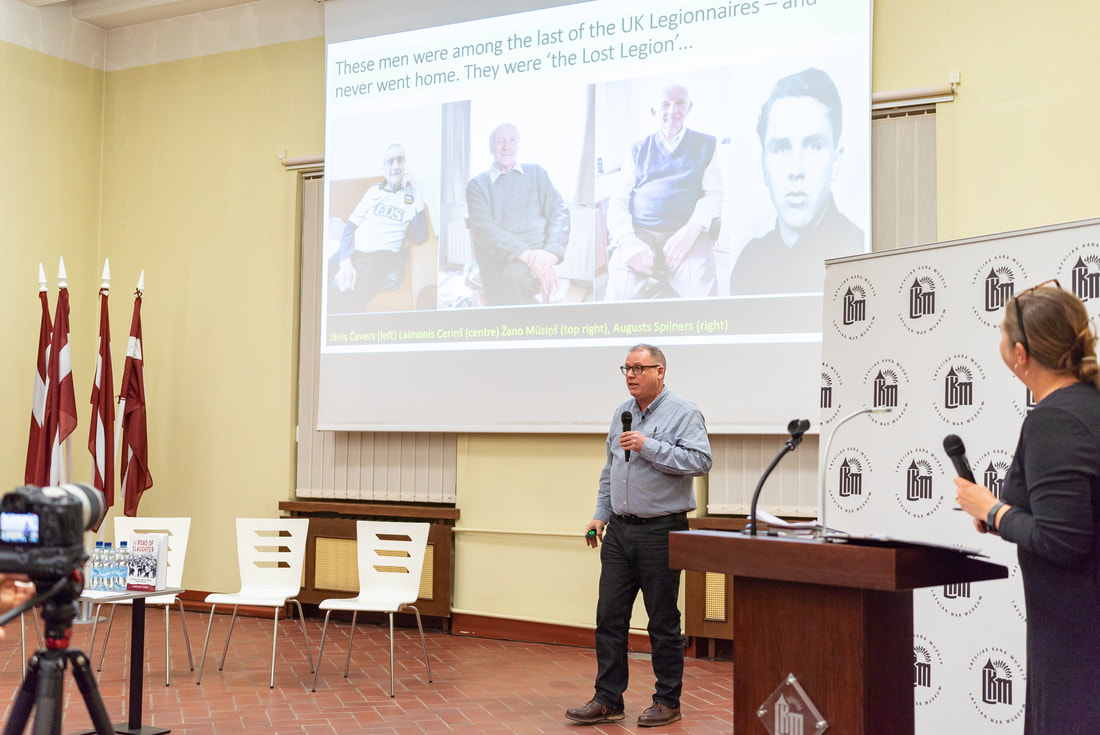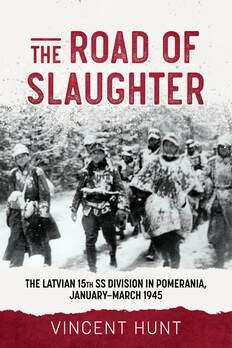AUTHOR RETURNS ‘LOST LEGION’ STORIES TO LATVIA – WITH NEW EVIDENCE OF MASSACRE RESPONSIBILITY
Having spent six years collecting stories about the Latvian Legion’s 15th Division in Pomerania and Germany in 1945, the author returned to Latvia to launch his latest book – The Road of Slaughter – at the War Museum in Riga.
The launch was part of an historical analysis of the journey of the division across what is now Poland between January and March 1945 alongside Latvian historians Jānis Tomaševskis and Valdis Kuzmins, with Aivars Sinka from the veterans’ association Daugavas Vanagi. The event was introduced by the deputy director of the War Museum, Juris Ciganovs.
The launch was part of an historical analysis of the journey of the division across what is now Poland between January and March 1945 alongside Latvian historians Jānis Tomaševskis and Valdis Kuzmins, with Aivars Sinka from the veterans’ association Daugavas Vanagi. The event was introduced by the deputy director of the War Museum, Juris Ciganovs.
The author presented excerpts from the memories of survivors with new details that have emerged which shed new light on the most controversial episode of the Latvian experience in Pomerania – the massacre of 32 Polish prisoners at Flederborn, now Podgaje, on 3rd February 1945. New evidence adds even greater weight to the theory that the killings 78 years ago were carried out by the German-Dutch 48th SS and not the Latvians.
“A soldier who was there and later came to the UK told his son that the prisoners were machine-gunned on an icy pond in Flederborn,” the author told the hall. “His story was consistent each time. They were killed by the German-Dutch 48th SS.”
Tens of thousands of Latvians were drafted into the 15th SS Division during 1944 to rebuild the unit, badly mauled in the Soviet summer offensive that year. Under-trained and short of weapons, they were thrown into battle to stop the Soviet Vistula-Oder offensive, ending up in a chaotic and bloody seven-week retreat to the Oder and then into Germany. Most of the men never returned home, becoming the 'Lost Legion'.
During the research for the book, Hunt assembled a chronology of events on the road between Jastrow and Landeck (Jastrowie and Ledyczek) which suggests that between 3,500 and 5,000 Latvians may have died along a 15km stretch of road.
The Road of Slaughter is the first instalment of that journey to the West, and is available to buy from Helion at https://www.helion.co.uk/military-history-books/the-road-of-slaughter-the-latvian-15th-ss-division-in-pomerania-january-march-1945.php
“A soldier who was there and later came to the UK told his son that the prisoners were machine-gunned on an icy pond in Flederborn,” the author told the hall. “His story was consistent each time. They were killed by the German-Dutch 48th SS.”
Tens of thousands of Latvians were drafted into the 15th SS Division during 1944 to rebuild the unit, badly mauled in the Soviet summer offensive that year. Under-trained and short of weapons, they were thrown into battle to stop the Soviet Vistula-Oder offensive, ending up in a chaotic and bloody seven-week retreat to the Oder and then into Germany. Most of the men never returned home, becoming the 'Lost Legion'.
During the research for the book, Hunt assembled a chronology of events on the road between Jastrow and Landeck (Jastrowie and Ledyczek) which suggests that between 3,500 and 5,000 Latvians may have died along a 15km stretch of road.
The Road of Slaughter is the first instalment of that journey to the West, and is available to buy from Helion at https://www.helion.co.uk/military-history-books/the-road-of-slaughter-the-latvian-15th-ss-division-in-pomerania-january-march-1945.php



